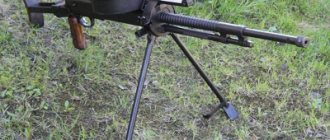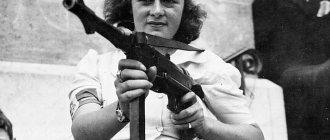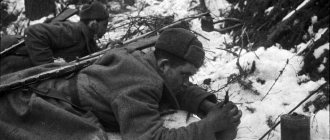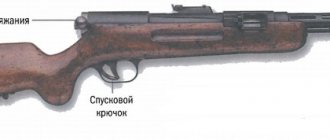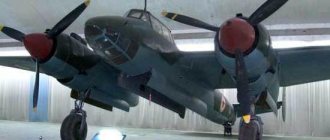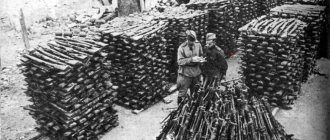A bayonet is a cold bladed weapon that is attached to a hand-held long-barreled firearm and is intended for use in hand-to-hand combat against an enemy. Bayonets have the same damaging qualities that are characteristic of piercing and piercing-cutting weapons.
Based on history, at the end of the 50s, development work was carried out by military specialists, during which they made a very important conclusion and stated that the bayonet knife is still a symbol of will and the desire for victory, so it must be with a Kalashnikov assault rifle. Accordingly, Soviet soldiers had to master hand-to-hand combat using a bayonet and butt, and must undergo physical, technical and psychological training in order to skillfully behave and be prepared for such a fight.
Requirements for bayonets
Due to the fact that in hand-to-hand combat this type of weapon is considered to be the most effective, it must meet the following requirements:
- When used, the bayonet must inflict wounds that will quickly incapacitate the enemy. Based on this requirement, the shape and length of the bayonet blade are taken into account. It is immediately worth noting that bayonets come in needle and blade types;
- knives must have minimal weight, but at the same time have high strength;
- during combat, the existing bayonet should in no case become a hindrance, its presence should not interfere with high-quality maneuvering of the weapon, impair shooting accuracy and affect the stability of the battle;
- This edged combat weapon must be securely fastened, but at the same time, the warrior must be able to quickly bring it into combat readiness.
If we talk about the differences between needle and blade bayonets, then the needle was used only to perform its main and single function, that is, bayonet fighting. While a bladed bayonet, or as it is also called a bayonet-knife, was also used to inflict damage on the enemy when held in the hand. It was also used for such purposes: cutting branches, digging in, using it as a knife and even a dagger.
Peculiarities
HP-40 (the standard model of a combat knife) has its own characteristics. First of all, it was a weapon - a means to defeat the enemy. This is the main feature of the blade. The guard has an unusual bend, not typical for knives. The S-shaped crosshair of the guard is made with a “reverse” bend. From the side of the blade it bends towards the blade.
The HP-40 reconnaissance knife is exclusively a combat weapon. A “working” grip was considered to be an inverted straight grip with the blade pointing upward. This way it was possible to hit a person in the hypochondrium and abdomen. Reverse - allowed you to strike in the neck. With both grips, the weapon rests in the hand in an inverted position; in fact, the guard was made for these deadly blows. Experts note the design of the scabbard. It is more typical for dirks or long blades. Another detail is typical for weapons such as the HP-40 scout knife - a large heel (an area that does not have a sharpening) in front of the guard. It allows you to place your finger on the blade, enhancing its effect. The wooden handle had a small “belly”, which made it possible to determine the position of the blade by touch and fits very comfortably in the hand.
Development of the Soviet bayonet knife
The intensive development of bayonet knives occurred in the period 1918-1945; the main trend in their development was a decrease in the number of bayonets that were intended for the same types of carbine and rifles. At the same time, improved and developed samples of automatic, repeating and self-loading carbines and rifles were equipped with such mounts that made it possible to use existing models of bayonet knives, or required only minor modernization. In those days, bayonets were used to equip not only the main types of rifles and carbines, but also submachine guns, and even some models of light machine guns. But it is worth noting that this use of bayonets was not justified, since it significantly burdened the firearm.
Countries participating in World War II generally armed their soldiers with standard self-loading and repeating rifles and carbines, which were equipped with bayonets. It is worth noting that the use of bayonets on the battlefield showed negligible significance and bayonet battles, including attacks, brought absolutely no results and did not in any way affect the overall course of the war. At the same time, the leaders understood that the presence of edged weapons should be mandatory for a warrior, and it would be desirable for them to be multifunctional and compact. Why is the compactness of edged weapons so important? This requirement was explained by the fact that the army was constantly being saturated and replenished with military equipment and more advanced weapons. And when military equipment and personnel were transported, a long bayonet was only a significant obstacle.
From the above, we can conclude that the use of the bayonet did not justify itself on the battlefield; moreover, it became an extremely inconvenient edged weapon as the saturation of the Russian army with weapons and equipment increased. It would be much more convenient to use knives as edged weapons that combine several functions, are conveniently attached and are light and easy to use. That is, this weapon should be, first of all, a tool, a survival knife, and only then combined with a bayonet.
In the 1950s, a universal and combined edged weapon was created - the Soviet bayonet knife , which, one might say, became a successful solution to military operations related to close combat. Currently, this type of military weapon has become practically the only type that is actively used in close combat and combines the basic necessary functions, namely, a knife, a tool and only then a bayonet. This weapon model is an ideal example that has become extremely popular and has been improved several times over the course of its development. Before considering the main models of bayonet knives of the Russian army , first you need to find out in detail what bayonet knives are in terms of the shape and cross-section of the blade.
Varieties of bayonet knives according to the shape and cross-section of the blade
Blade bayonet knives are divided into four groups according to the shape and cross-section of the blade, namely:
- samples with single-edged monocotyledonous blades. Most of these models have the tip of the blade at the midline, which provides maximum penetration when striking soft tissue. As an example of such bayonet knives, we can take the English bayonets M 1907, Japanese bayonets type 30, Canadian bayonets M 1908. Some models of bayonets with single-edged bayonets were equipped with a saw on the butt, for example, like the German bayonet M 98/05. Non-commissioned officers, sappers and orderlies were equipped with such models;
- models of bayonet knives with single-edged blades of a T-shaped section. An example of such a model is the Dutch bayonet of 1895. Such models are also classified as dagger bayonets and stiletto bayonets;
- bayonet knives with double-edged blades; sometimes you can also hear them called bayonets-daggers. The blades of such models can be asymmetrically or symmetrically double-edged. If this is an asymmetrical design, then sharpening the blade is from its tip to the middle;
- models of stiletto bayonets with needle blades, sometimes you can hear their name as bayonets-daggers. These samples have a metal handle, which makes them not very convenient to use, but extremely useful as a piercing weapon in close hand-to-hand combat. A striking example of such a bayonet knife is the French M bayonet of 1886, as well as its subsequent variations.
Sample bayonet knife 6x2
The official designation of this Russian bayonet knife is 26-X-212. Based on history, in the USSR AK and AKS were manufactured and produced in the period from 1949 to 1960. During this period of time, changes were made to the design features of the weapon, as well as to the methods of its manufacture, which, first of all, were aimed at reducing the cost of production and increasing the performance characteristics of the weapon itself. If we talk about today, there are many collectors who collect these types of weapons in their collection and conditionally divide the AK and AKS series into three types:
- the initial and very first modification of the AK and AKS, which dates back to 1949, the production of this model lasted until 1951;
- transitional modification of AK and AKS, its production lasted from 1952 to 1955;
- lightweight model of AK and AKS, which was produced from 1955 to 1960. This modernization became widespread throughout the world, but was stopped in production due to the adoption of the modernized Kalashnikov assault rifle.
The 6x2 model bayonet, along with AK and AKS assault rifles, as well as AKM and AKMS, were supplied to various countries. It is also worth noting that copies of the bayonet were made in various countries, such as North Korea, Indonesia, Bulgaria, China, and Germany. If we talk about characteristics, Soviet bayonet knives have the following features: the total length of the weapon is 315 mm, the length of the blade is 205 mm, the width of the blade is 21.8 mm, the internal diameter of the ring in the cross is 17.7 mm. The bayonet blade has one blade and fullers on the sides. The handle of a bladed weapon is formed from two red-brown plastic cheeks, which are fastened together with two screws.
The machine has special fastening devices, which consist of a ring for putting on the barrel and a spring-loaded latch in the cross. In addition, the composition includes two semi-circular brackets on the head of the handle. Visually, the bayonet knife also has its own distinctive features, in particular, the manufacturer’s mark is visible on the crosspiece, and a number is stamped on the head of the handle, which is located at an angle in relation to the blade of the bayonet. The sheath is made of steel and has two belt clips. If it is a hanging belt, then canvas or leather is used to make it.
If you look at photos from Monetchikov on the Internet or other sources, then 6x2 is the same as 6x1 or 56-X-212. If we talk about 6x1, then its total length is 310 mm, blade length - 200 mm, blade width - 22 mm, it remained experimental, since for mounting it only required reworking old machine guns or new ones, but with a stop under the gas chamber. This variation was later implemented for Russian 6x3 bayonets.
6x1 was made with a single-edged blade and one fuller; its handle was formed by wooden grooved cheeks, which were fastened with two screws by the shank of the blade. The sheath is black steel and has two belt clips.
Features of the 6x3 bayonet knife model
This model is considered a knife for naval reconnaissance scuba divers and was developed by Lieutenant Colonel Todorov of the naval service in 1955-1956 during the defense of Leningrad in the Great Patriotic War. It was at this time that this bayonet and knife was offered to the USSR Navy Department. It is known that the knife was experimental, but in what quantity it was produced is unknown; it was used mainly in Sevastopol. The weapon was attached to the belt and had a special hole in the blade, which made it possible to attach an additional part. All this made it possible with a knife not only to saw, but also to cut through wire and metal rods.
A little later, this model of knife came to the attention of Kalashnikov employees, who at that time were developing a new bayonet knife for the AKM assault rifle. The 6x3 model was completely copied, with the exception of the processing of several components, but the blade practically retained its original appearance. Subsequently, this model began to be copied in all countries of the world, playing with the shapes of these weapons, like with a construction set. The 6x3 bayonet knife was adopted for service together with the Kalashnikov AKM assault rifle in 1959 and since 1963 it has even been used with the Dragunov SVD sniper rifle. This bayonet model was supplied with AKM assault rifles to various countries, and its copies were produced in Romania, East Germany, Hungary, and Poland.
The distinctive features of the bayonet are as follows: total length 246 cm, blade width 30 mm, blade length 140 cm, total weight with leather sheath 341 g, without it 267 grams. The bayonet is characterized by a single-edged blade, the combat end is double-edged and has a concave blade on the butt side. In order to be able to use the bayonet in the form of a saw, a notch was created on the butt of the blade as teeth. The blade in its front part has a special rectangular hole, which allows it to be attached to a sheath and used as a wire cutter. The handle of the knife bayonet is formed by plastic cheeks, which are fastened with two rivets to the shank of the blade.
As for the cross with the ring, they are located on the side of the blade blade. The handle head consists of a spring latch, which has an internal spring and a T-shaped groove. The button of this springy latch has a guard in the form of a plastic side. The sheath is made of steel, its upper part is covered with a special rubber pad, which also acts as an insulator; when you wrap your hand around it and bite live wires, it reliably protects. The bayonet knife is inserted into a hanging belt, which is made of leather.
The metal parts of the bayonet and scabbard have stamps indicating that they have passed technical control. An individual number is applied to the bayonet using a stamp on the crosspiece, and the same number is repeated on the scabbard cutter. The manufacturer's seal is located in the place where the cross protrudes, that is, on the side of the back of the handle near the ring. The mark of the Izhevsk arms factory is more common and much less common of the Tula arms factory. The latter have slightly different parameters: total length 280 mm, blade length 150 mm, blade width 30 mm with an internal diameter of the ring in the cross 17.7 mm.
Characteristics of the 6x4 bayonet knife model
The Russian bayonet knife model 6x4 is in principle identical to the 6x3 model, only slightly improved and differs from its predecessor in the shape of the handle, which has a metal head. This sample is transported to many countries along with AKM assault rifles. Its main characteristics are:
- the blade of this bayonet is single-edged;
- the combat end has a double blade with a concavity on the side of the butt;
- to make it possible to use the bayonet as a saw, a special notch in the shape of teeth was formed on the butt;
- the front part of the blade has a rectangular hole, which allows the warrior to attach the bayonet to the sheath and use the resulting structure as wire cutters;
- the handle consists of a plastic patch, which is attached to the shank of the blade with only one single rivet;
- on the side of the blade there is a cross with a ring;
- in the head of the handle there is a T-shaped groove and a spring latch, where the spiral spring has an internal arrangement;
- the sheath is made of high-quality steel and is covered with plastic along almost its entire length, only with the exception of the place that is used as a wire cutter;
- The hanging strap is made of leather.
As for the technical control stamps, they are on the metal parts of the scabbard and bayonet. Plastic parts have mold numbers and QC ink stamps. The number on the bayonet is stamped on the handle and is located parallel to the blade or perpendicular. The number is also repeated on the scabbard. In addition, there is a manufacturer’s mark on the scabbard and the bayonet handle; these could be signs of the Tula or Izhevsk arms factories. This model of bayonets was manufactured and produced over several decades, given the time of production, the bayonets may have some differences in small details or in markings.
Soviet bayonet knives of the 6x4 model have a total length of 270 cm, a blade length of 150 mm, a blade width of 30 mm and an internal diameter of the ring in the cross of 17.7 mm. In addition to this standard sample, a lighter version was also produced, but it is worth noting that this simplified version was very quickly abandoned. This was due to the fact that significant savings led to an increase in the number of technological operations, which was an extremely inconvenient and unprofitable undertaking.
I would also like to note that the 6x4 bayonet knife model is the most common throughout the world and is supplied to almost all states that are friendly to the USSR. The design of this sample became the basis for the manufacture of a bayonet knife for the HK G36 rifle. The only difference between these two samples is that the latter has a larger diameter of the mounting ring on the guard.
Model bayonet knife 6x5 and its main features and advantages
As a rule, this sample bayonet knife is used with AK-74 and AK-74M assault rifles, but can also be used with AK Sotto and AN-94 assault rifles. The main features of this model are:
- single-edged knife blade with a silver and matte finish;
- the butt of the blade has a special notch in the form of teeth, which allow the device to be used as a saw;
- the front part of the blade has a rectangular hole, which makes it possible to attach the blade to a sheath and use the resulting structure as wire cutters;
- the handle is made of plastic, has a plum or black color, and also has three transverse ribs, which makes it comfortable to hold;
- the crosspiece with the ring is located on the side of the blade blade;
- the head of the handle is equipped with a T-shaped groove and a spring latch, which has an internal spring arrangement;
- the sheath is covered almost along its entire length with plastic, plum and black in color, with the exception of the part that is used as wire cutters;
- The belt is suspended and made of leather.
The scabbard of the knife bayonet has a mark, which indicates that the manufacturer is the Izhevsk Machine-Building Plant. In addition, the scabbard contains stamps from the technical control department. Identical stamps are also found on the bayonet blade. There is also a three-digit number on the sheath and handle. The head of the handle and the place that is located between the stiffening ribs on the scabbard are characterized by the number of the casting mold. It is worth noting that depending on the number of the casting mold that was used in the manufacture of the handle, it may differ in surface treatment. There are also several variants of the bayonet knife that differ in the color of the plastic parts.
The total length of this model knife bayonet is 290 mm, the blade length is 160 mm, the blade width is 29 mm, and the internal diameter of the ring in the cross is 17.7 mm. clearly see what a Russian bayonet knife looks like in the photo .
Methods of fastening bayonets and bayonet knives
The bayonet must be fixed in such a way that it can provide greater strength and, even to a lesser extent, not move during shooting, as this leads to a decrease in accuracy due to a shift in the center of gravity of the weapon. These requirements apply to absolutely all types of bayonets, especially if shooting is carried out with a fixed bayonet. The optimal and most profitable option for attaching a bayonet with a tube to a rifle is that during shooting the deflection of the bullet goes in the opposite direction to the deflection due to a shift in the center of gravity. In other words, if the bullet deflects from deflection to the left, then the bayonet must be attached to the left side. At a time when the bayonet is attached to the tip of the fore-end of the stock, it has the least influence on the vibrations of the barrel during its action, which cannot be said about its attachment to the barrel itself.
When the bayonet is attached directly to the barrel itself, it provides greater strength and reliability, but with such fastening the barrel experiences significant loads. This point was taken into account when choosing the thickness of the barrel wall at the muzzle. If we talk about attaching the bayonet to the tip of the fore-end of the stock, this reduced the load on the barrel, but did not contribute to the formation of a reliable and durable connection. But, despite this, this type of fastening helped to reduce the harmful effects on the surface of the blade, namely, powder gases that escape during the firing process. Based on all these points, a compromise decision was made to attach the bayonet to the barrel and the upper stock ring at the same time; this helped relieve the barrel from significant load and ensure a strong, reliable fastening of the bayonet. When the bayonet was mounted in this way on the barrel of a rifle or carbine, it usually had a T-shaped longitudinal groove, a ring in the crosspiece and a spring latch in the head of the handle.
There were also other options for attaching Russian bayonet knives , in particular:
- such a fastening option when the spring latch button was located not in the head of the handle, but at the crosspiece;
- when the spring latch was in the ring of the cross, such fastening ensured a silent connection, without the characteristic click;
- mounting option when putting the cross ring on a special rod, and not on the barrel itself;
- when the hollow handle is put on a special rod, which is located under the rifle barrel.
If we judge which option for attaching a bayonet is the most successful, namely, detachable or non-detachable, then it is worth noting that both of them have their advantages and disadvantages. For example, if you take a bladed detachable bayonet knife of the 6x4 sample, which goes to the Kalashnikov AK-74 assault rifle, then it is used not only as a weapon during a fight with the enemy, but also for other various purposes that may arise during combat or marching services. Considering this point, it would be more advisable to have a bayonet knife with a detachable mount. At the same time, the permanent mount also has its advantages; a fighter can use a bayonet knife at any moment during a fight and deliver a bayonet strike to the enemy, while eliminating the possibility of losing it during the battle.
An example of an integral bayonet attachment is the Simonov SKS self-loading carbine; this weapon was discontinued back in 1950, but at the same time, the carbine is still in service with Russian honor guard companies. I would like to note that this weapon was recognized as one of the best and most beautiful examples of representative military weapons.
If we go back to the first half of the 20th century, both needle and blade bayonets have found quite widespread use in domestic small arms. Needle bayonets were used for rifles of the 1891-1930 model, and for the 1944 carbine. Bladed bayonets were used for the Simonov automatic rifle of 1936, and for the Tokarev SVT self-loading rifles of the 1938 and 1940 models. Already since the 1950s, the legendary Kalashnikov AK and AKM assault rifles were adopted in the Soviet Armed Forces, along with them bayonet knives were widely used.
In order to understand how a needle bayonet worked, you can consider it using the example of the Mosin repeating rifle of 1891-1930. A needle-type bayonet has a tetrahedral blade and has a neck that connects the tube to the blade. The composition also includes a tube, thanks to which the bayonet could be freely put on the muzzle of the barrel, and a spring latch. The cross section of the blade of needle bayonets has the shape of a quadrangle. The side edges of the blade have longitudinal grooves called fullers. Such a needle bayonet, equipped with fullers, cut the fibers when penetrating the body, and the fullers contributed to the flow of blood from the wound. Also, the presence of the fuller reduced resistance to penetration into the body and reduced the mass of the bayonet, which gave it the necessary strength.
The blade of the needle bayonet had a pointed combat end, which was blunted and had a platform 0.5 mm wide. It was this platform that served to protect the fighter from unintentional injuries. The length of the bayonet itself was 435 mm. If we talk about the direction of the blade axis, then together with the direction of the tube axis they created an angle equal to 2 degrees. Thanks to this direction of the blade axis, the bayonet axis went through the center of gravity of the rifle and passed between the shooter’s hands that held it. All this made it possible to achieve a greater impact effect, and eliminated the possibility of twisting the weapon in the hands when carrying out a strike.
Use of bayonet knives today
If we talk about today's modern world, in particular about today, then in almost all countries the armed forces are not going to give up the use of bayonet knives. This is due not only to a centuries-old tradition, but also to the fact that at the moment there is no suitable replacement for a bayonet with a knife, which is necessary for training aggressiveness and acquiring the skills of escorting prisoners. Today, many specialists are working on creating new models of bayonet knives; it is worth noting that, most likely, further development will largely be directed towards this type of bladed weapon with maximum versatility. Taking into account new trends, we can highlight the most basic criteria and requirements that are taken into account when developing new models of bayonet knives. Such criteria and requirements include:
- blade shape and size;
- the possibility of this blade forming wide wounds and the possibility of quickly removing it from the body in order to strike again;
- the possibility of using another type of weapon when the bayonet of the knife is in the hand;
- speed and speed of use;
- The bayonet and knife must be held comfortably in the hand while the soldier is crawling.
Despite all the above criteria, most experts today consider the idea of creating a multifunctional bayonet knife to be unfeasible. Everyone has long understood that the function of the bayonet, which operates in combination, first the bayonet, then the tool and then the knife, has long faded into the background, which was clearly demonstrated in the wars that existed in the second half of the 20th century. Usually in these wars, hand-to-hand combat broke out suddenly, and very often the soldiers simply did not have time to carry out the bayonet connection. Most often during the battle, the butt of the weapon and the barrel, combat knives, bayonet knives, and sapper blades, which were not attached directly to the weapon, were used. Given the fact that repeating rifles were replaced by machine guns that had a pistol grip, this led to the fact that delivering a bayonet strike with a bayonet attached to the weapon became extremely inconvenient.
But, despite all these problems, work on creating new samples and models of bayonet knives has not stopped. Today, experts are trying to combine a bayonet knife and a survival knife, which will become a fairly multifunctional and very convenient model of edged weapons. If we take into account statistics and evaluate the prospects of such weapons, we can conclude that, after a few decades, the bayonet knife will finally retire and give way to special types of edged weapons. Most likely, this special edged weapon will not be used for machine guns.
Alloys that are used to create steels for bayonet knives
Most often, steel contains oxygen, which is the main chemical element and determines the properties of steel. It is the amount of carbon content in steel that will determine its strength and hardness. But it is worth noting that due to the carbon, the future bayonet knife may be subject to hardening. Although carbon promotes the development of corrosion, its content should therefore be at least 0.6%. The second most important element found in steel is chromium, which makes it stainless and increases its resistance to corrosion. The chromium content must be at least 14%. As a rule, this element has an undeniable advantage, but it has a rather negative effect on strength.
In the manufacture of steel, an additive such as molybdenum is also used, which increases heat resistance and has anti-corrosion properties. In addition, vanadium is also used, which increases strength and wear resistance, and tungsten, which ensures temperature resistance and hardness of the product. If experts decide to replace carbon and nickel, then nitrogen is used as a substitute, which not only increases corrosion resistance, but also makes it possible to harden steel, even taking into account the low carbon content. The following chemical elements may also be present in steel alloys: silicon, manganese, nickel, niobium, sulfur, titanium, phosphorus. All of the above elements have a positive effect on the technical characteristics of the metal, which is subsequently used to create a bayonet knife.
Blade surface coating
If it is intended that the blade should not attract the attention of an opponent, then it is coated with a special matte coating, which eliminates the shine of the metal. Every year, blade metal processing becomes more and more inventive, because today it is possible not only to matt steel, but also to provide it with hardening of the surface layer and protection against corrosion. Today there are many processing methods, among which special coating and mechanical processing are distinguished. The most common machining methods are:
- satin finishing - when metal is processed with grinding materials. This leads to the fact that the top layer of the blade is slightly scratched and a streaked knot appears. The saturation of the matte shade will depend on the grain size of the tool;
- grinding - this method involves polishing the blade using rolling stones combined with grinding material;
- Jetting is the easiest way to achieve a rich matte finish. This treatment consists of the following: under high pressure, small particles of a particular substance are scattered over the entire surface of the metal. The small particles obtained due to high pressure can be glass or corundum. The jetting method leads to roughness, which subsequently contributes to rusting. As for glass particles, when they fall on the surface of the metal, they become compacted and contribute to the metal’s resistance to damage.
The blade is coated with a special material, which can be very different and gives not only a matte finish, but also protects the metal from corrosion. Coatings may differ and have different compositions, most often these are powder and varnish coatings. For the price they are not too expensive. In addition, there are also products consisting of hard metals, but their cost will be much more expensive.
" Soviet bayonet knife" read 4600 times


